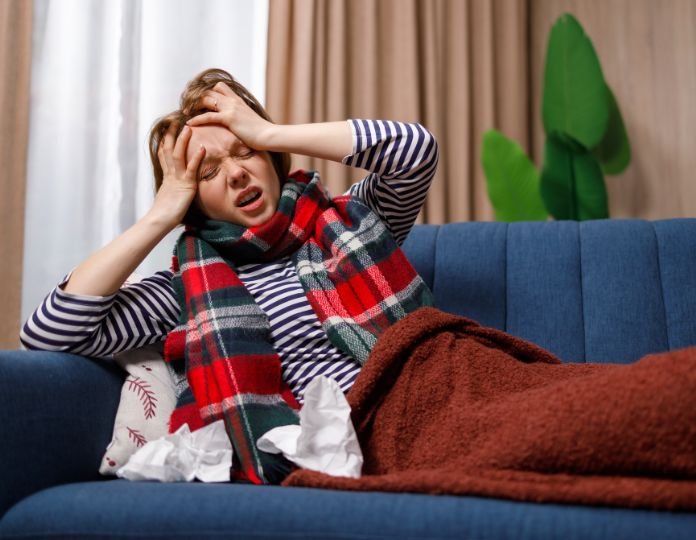A migraine headache generates severe pulsating or throbbing sensations. Migraines can be triggered by a variety of circumstances, including seasonal variations.As per research, some “substances or conditions” might cause a migraine attack, including some of the subtle changes that occur when the seasons change. These triggers might not impact everybody, but expecting their arrival might help people manage their migraines. Changing barometric pressure, commonly known as atmospheric pressure, can produce migraines. As the seasons change, barometric pressure varies, which might lead to an attack.
As explained by various psychiatrists “Our heads are full of air pockets known as sinuses. Typically, those pockets of air are in balance with the atmospheric pressure,”. Whenever there’s a change in the atmospheric pressure, it creates a kind of shift between what you’re experiencing in your head and what’s going on in the air.” That rapid shift may cause a migraine.
Read More: Recognizing Your Own Triggers
A tiny Japanese research investigated whether lowering barometric pressure, occurring before a storm could be a cause of headaches. It was discovered that 75% of migraine sufferers got migraine episodes as a result of the reduction in barometric pressures. Similarly, shifting temperatures, such as a warm summer transitioning to a chilly fall or freezing winter temperatures rising into a pleasant spring, can be a migraine trigger. Other seasonal or weather-related causes are:
- Humidity or Dry Air
- Windy or stormy weather
- Bright sunshine or sun glare
- Extremely hot or chilly heatwaves
What to Keep an Eye on Each Season?
Spring Migraine Triggers
The spring can see frequent fluctuations between sun and rain, indicating that barometric pressure is shifting, which can be a migraine trigger. Spring may also be a difficult time for folks who have seasonal allergies. Migraines are not caused by allergens, yet they are sometimes misunderstood as sinus headaches. Migraine episodes frequently accompany sinus symptoms such as runny nose and watery eyes, although fever and discharge indicate sinus problems rather than migraines.
Summer Migraine Triggers
This season is hot and humid, and individuals sweat more, which can cause dehydration. Doctors advise migraine sufferers to stay hydrated to avoid an attack. Summer brings more sunlight and longer days, which can disrupt people’s sleep cycles and perhaps provoke migraines. An irregular sleep cycle can cause migraines, so check your sleep and ensure you’re getting adequate rest. Sun glare can also cause an attack, thus wearing a hat or sunglasses might help alleviate this trigger.

Fall Migraine Triggers
This is the time of year when lower temperatures arrive, so there will be temperature variations at the start of the season. As the days become windier, humidity will drop and barometric pressure will alter. However, there is another component of autumn that you may not expect: The days are becoming shorter, which might disrupt your sleep routine and cause migraine symptoms.
Winter Migraine Triggers
Winter is typically associated with chilly weather, dry air, and snowstorms. Chilly and dry air might cause dehydration, especially if you turn up the heat in your house. Snowstorms in winter are also linked to deviations in barometric pressure, which might be a cause for migraines.
Reducing Seasonal Triggers
While you may avoid drinking red wine or wearing noise-cancelling headphones in busy settings, you can’t completely escape the weather. However, many of the preventative actions advised year-round to decrease migraine episodes are equally helpful against seasonal triggers.
The most crucial way is to have a steady routine. “The migraine brain craves for schedule, so try to maintain a normal schedule as much as possible. Migraine sufferers should monitor their nutrition, activity, and sleep cycles. Taking care of these parts of your life will help you better prepare for seasonal and weather-related triggers when they come.
In the spring, one should be mindful of the weather to see whether variations in barometric pressure are a trigger, so one can be prepared on the prior basis to treat an attack.

When summer arrives, drink more water than normal to keep yourself hydrated. If you are allergic to tree, grass, or weed pollen, you should continue to take allergy drugs.
During the fall, try to avoid contracting the colds that frequently circulate when temperatures drop. Wear weather-appropriate clothes, particularly caps, to keep your body warm, and avoid contact with anyone who is already ill. If you see any warning signs of illness, take urgent action to prevent your symptoms from deteriorating.
People suffering from migraines should drink more water during the winter months since indoor heating dries out the air. A humidifier can assist in maintaining moisture in your surroundings.
Read More: Understanding Chronic Pain: Causes, Symptoms, and Treatment Options
Myths Regarding Migraine Triggers
Myth 1
Light sensitivity is always a migraine cause.
While light can be a migraine trigger for some people, it is also a warning indication that a migraine episode has started. In many circumstances, light sensitivity occurs during the prodrome stage of a migraine episode. This might indicate that specific light levels or colours cause pain or discomfort, or it could simply mean that you are reacting more than normal to certain forms of illumination, such as sunshine, glare, or fluorescent lights. So, while light sensitivity may indicate that a headache is on its way, it does not always indicate that light is the source of the migraine.
Myth 2
Chocolate may cause a migraine attack.
Foods that might cause migraines vary from person to person, and even within the same individual from one attack to the next. Although chocolate can cause headaches for certain people, chocolate cravings can also occur during the migraine prodrome stage. Similar to light sensitivity, when prodrome symptoms include food cravings, it is easy to misinterpret them as signals of an impending attack.
Instead of eliminating all items that have been proven to cause migraines, keep a food and snack log. This might assist you in determining which meals are effective in alleviating migraine symptoms. This can also help you watch out for other variables like sleep and stress. When it comes to chocolate, Dr. Alison Thaler, a neurologist and a member of the American Migraine Foundation’s Editorial Board, believes that a modest quantity of caffeine may be beneficial during a migraine attack.

However, while moderate doses of caffeine taken at the outset of an attack may be beneficial in certain individuals, excessive caffeine (or regular use) has been linked to an increase in the frequency of attacks.
Myth 3
It’s okay to “ride out” a migraine to avoid taking medicine.
Headaches caused by drug usage are a serious issue for persons managing regular migraine symptoms, but this does not imply you should avoid treating an attack with acute medicine when you need it. Under-treating migraine bouts can exacerbate symptoms and make matters worse in the long run. Studies have shown that “prolonged exposure to pain can lead to a phenomenon called central sensitization, where the brain essentially gets ‘better’ at creating sensations of pain.” This implies that allowing oneself to be in agony throughout a migraine episode will raise your chances of having more attacks in the future.
Myth 4
If I don’t treat my migraine right away, I may as well stop treating it.
While the optimal time to treat a migraine attack is early on, when the pain is still minimal, there is still something you can do to ease symptoms later on. Most treatment methods will still be effective in the later phases of a migraine attack, though some may work better than others. Non-oral medications, such as nasal sprays and neuromodulation devices, maybe more helpful in managing migraine symptoms during the later stages of an attack, especially for people who suffer from GI symptoms as part of their migraine.
Myth 5
To be diagnosed with a migraine, you must first go through the aura phase.
You do not need to have aura to receive a diagnosis. Everyone’s migraine experience is unique, and there is no certainty that each individual will go through the whole migraine attack cycle. In reality, migraine without aura is more prevalent, with just 25 to 30% of migraine sufferers experiencing the aura phase of their attack. Furthermore, the symptoms of an attack’s aura phase differ from those of the prodrome phase, and not everyone experiences prodrome symptoms in the same manner. Getting an accurate diagnosis is the first step toward receiving the care you require, therefore you should never postpone seeing your doctor because your migraine symptoms differ from those of others.
Myth 6
Migraine is a mental health condition.
While there are clear links between migraine and mental health, migraine is not a mental health issue. Migraine is a debilitating neurological disorder that requires a specific combination of preventative and acute medications to be adequately managed. However, your migraine management strategy may include lifestyle modifications and techniques such as cognitive behavioural therapy and mindfulness to help you manage your migraine and frequent mental health triggers like stress. Furthermore, several mental health conditions are more frequent in persons with migraine, such as sadness and anxiety, and successfully managing these is a crucial part of the overall migraine treatment plan
Myth 7
Vomiting will relieve a migraine episode.
A migraine episode can cause many symptoms other than headaches, such as nausea and vomiting. As a result, some people report feeling better after vomiting during a migraine attack. However, purposely making yourself vomit can have a variety of serious health implications and will not relieve a migraine episode.

If you frequently feel nausea during migraine attacks, see your doctor about how to change your treatment regimen. A variety of non-oral drugs, including antiemetics, may act fast to relieve migraine symptoms [such as nausea] and severe gastrointestinal symptoms.
Read More: How does our Gut Health Influence Mental Well-Being? Here’s what Experts say
Precautionary Steps
Although migraines cannot always be avoided, there are efforts a person may take to reduce their frequency and intensity, such as:
- Botox Injections: Botulinum toxin, sometimes known as botox, may inhibit the chemicals in the brain that cause migraines.
- Lifestyle: Making thoughtful lifestyle decisions can help reduce migraine severity. For example, a person may ensure that they receive adequate sleep, consume nutritious foods, keep hydrated, and exercise regularly.
- Taking medicines as soon as symptoms appear: A person may also discover that taking medicine at the first symptom of a migraine episode is more effective than waiting until the headache becomes severe.
- Avoiding triggers: If a seasonal migraine arises, patients should monitor weather changes and stay indoors if feasible. Wearing a face covering that blocks allergens like pollen may also assist with allergies.
- Medication: Certain types of drugs can help prevent migraine headaches. Anticonvulsants, beta-blockers, and antidepressants, for example, may lessen the frequency of migraine attacks. A doctor may also give calcitonin gene-related peptide (CGRP) inhibitors as a novel therapy to reduce migraine frequency and drug use.
Seasonal Migraines are due to weather patterns such as temperature, humidity, and barometric pressure. A migraine sufferer should keep a notebook to identify their triggers. Seasonal migraine preventive methods, such as avoiding triggers, adopting informed lifestyle choices, and taking medication, may lower the frequency and severity of seasonal migraine attacks.
References +
- De Pietro Crt, M. (2022, April 29). Seasonal migraine: What are the triggers and causes? https://www.medicalnewstoday.com/articles/seasonal-migraines#summary
- 10 common migraine triggers and how to cope with them | NIH MedlinePlus Magazine. (n.d.). NIH MedlinePlus Magazine. https://magazine.medlineplus.gov/article/10-common-migraine-triggers-and-how-to-cope-with-them
- American Migraine Foundation. (2022, November 29). Seasonal Migraine | American Migraine Foundation. https://americanmigrainefoundation.org/resource-library/seasonal-migraine/
- American Migraine Foundation. (2023c, March 3). 7 Common myths about migraine | American Migraine Foundation. https://americanmigrainefoundation.org/resource-library/common-myths-about-migraine/













Leave feedback about this